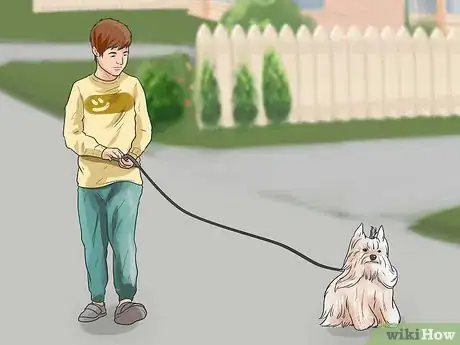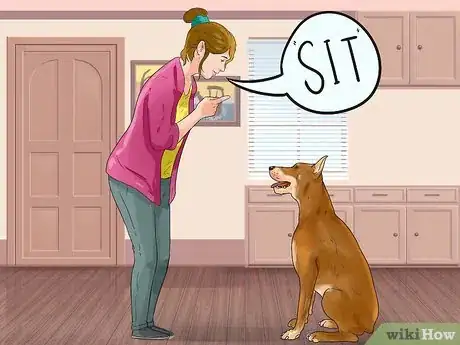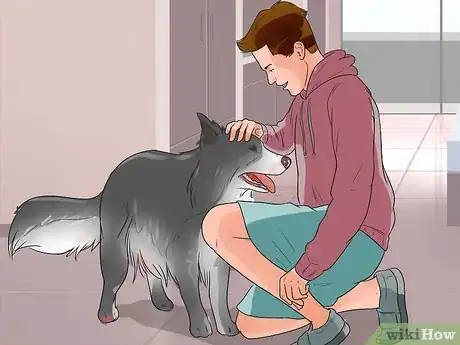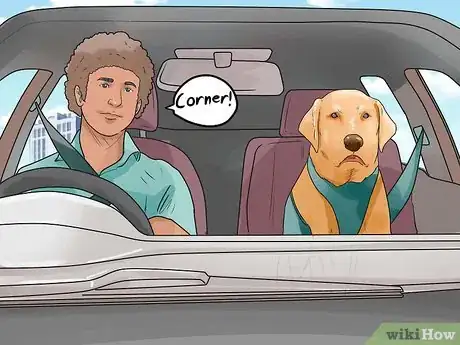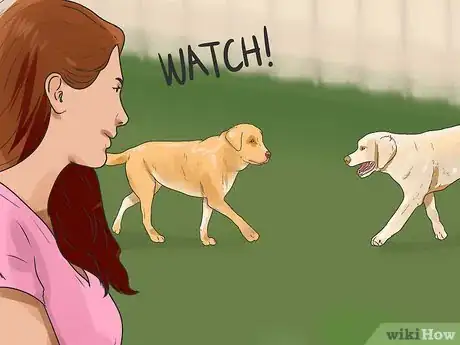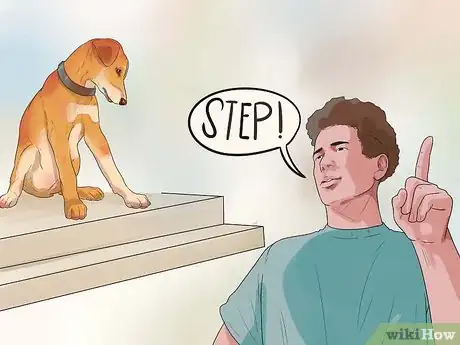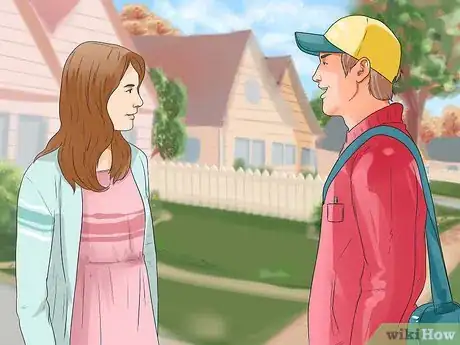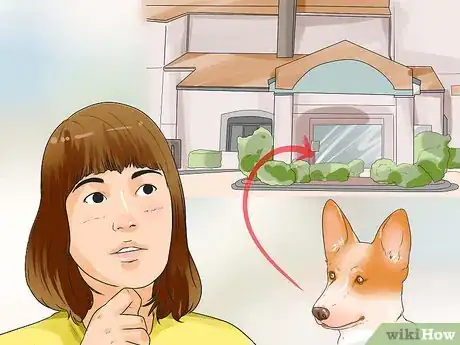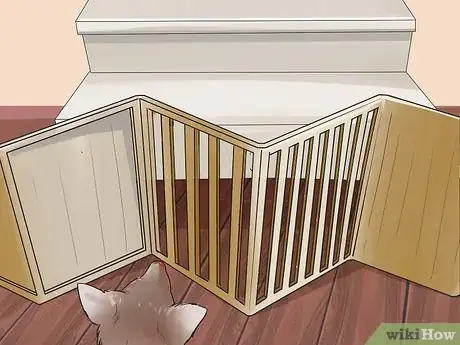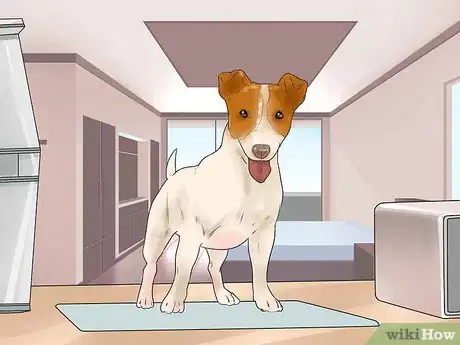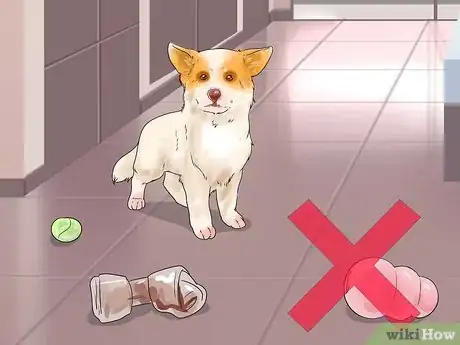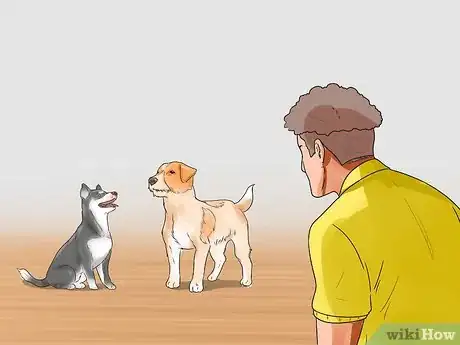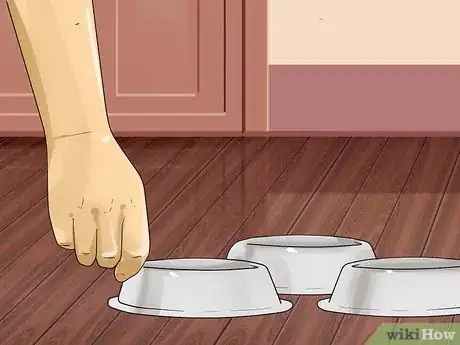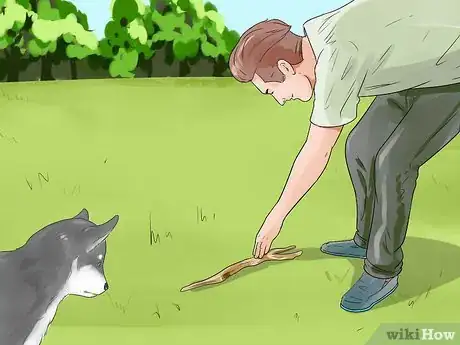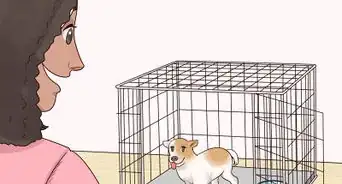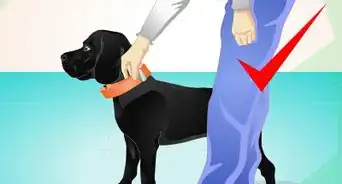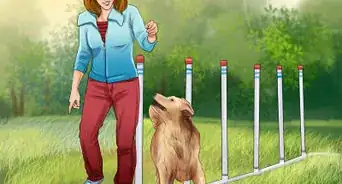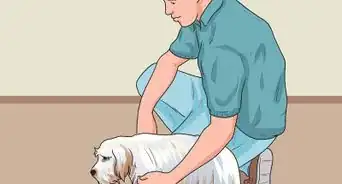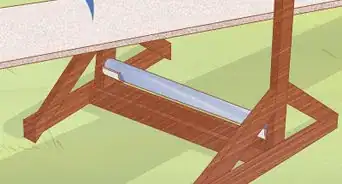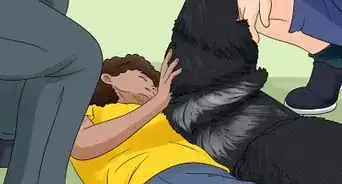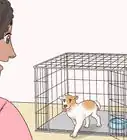This article was co-authored by Beverly Ulbrich. Beverly Ulbrich is a Dog Behaviorist and Trainer and the Founder of The Pooch Coach, a private dog training business based in the San Francisco Bay Area. She is a Certified CGC (Canine Good Citizen) Evaluator by the American Kennel Club and has served on the Board of Directors for the American Humane Association and Rocket Dog Rescue. She has been voted the best private dog trainer in the San Francisco Bay Area 4 times by SF Chronicle and by Bay Woof, and she has won 4 "Top Dog Blog" awards. She has also been featured on TV as a dog behavior expert. Beverly has over 18 years of dog behavior training experience and specializes in dog aggression and anxiety training. She has a Master of Business Administration from Santa Clara University and a BS from Rutgers University.
wikiHow marks an article as reader-approved once it receives enough positive feedback. In this case, 93% of readers who voted found the article helpful, earning it our reader-approved status.
This article has been viewed 36,961 times.
When dogs go blind,they quickly adjust to their surroundings as long as their humans help them.[1] You can help your dog adjust by making small changes in the way you exercise him and by teaching your dog verbal cues. Verbal cues can help you to tell your dog when he needs to move, step up, or even brace himself while riding in a car. It is also important to help your dog adjust to his environment by keeping him indoors and removing obstacles around the house. If you find that you are having behavioral issues or that your dog is having trouble navigating your house, then you may want to consult a dog trainer or talk to your dog's veterinarian for help.
Steps
Teaching Your Dog New Behaviors
-
1Exercise your dog as usual. You should continue to take your dog on walks to keep him healthy and maintain your bond. When you walk your dog, watch for obstacles that may cause your dog to trip and gently redirect your dog as needed.
- Using a back or front clip harness rather than a leash may give you a little more control over your dog and make it easier for you to guide him around obstacles.[2]
- Also, keep in mind that your dog will need reassurance if something noisy startles him. Pay attention to your surroundings and talk to your dog to let him know everything is okay.
- When you are out walking with your dog, do not let your blind dog get near strange dogs or people, especially children. Blind dogs may nip in defense if they become startled.
-
2Learn how verbal cues work. To train a dog to respond to verbal cues, you need to be consistent and always offer a reward when your dog responds to the cue. For example, to teach your dog to sit with the “sit” command, you would need to practice telling your dog to sit a few times every day. After each time that your dog responds to the cue by sitting, you would give your dog a treat and some praise.[3]
- Make sure that you offer the treat and praise right away. For example, you would need to give your dog his treat right after your dog’s bottom hits the floor so that he will make the connection that this is a good thing to do.
- Keep training sessions short to help your dog stay focused. Dogs have short attention spans, so it is best to keep training sessions under 10 minutes.
- End on a positive note. If your dog starts to get impatient, give him a command that he has already mastered, such as “sit,” then reward him with a treat and some praise and end the session.
Advertisement -
3Incorporate touch into your training sessions. Your dog can still feel and he will likely use his sense of touch to figure out how to get around the house.[4] You can use your dog's sense of touch to help train him as well.. To use touch in training sessions, you can do things like using the leash to steer your dog in the direction that you want him to go or applying gentle pressure to his body to get him to complete a command.
- For example, if you are teaching your dog the "sit" command, you might place one hand on his behind and apply gentle pressure to help him understand what you are asking him to do.
-
4Use the “corner” cue to help your dog brace himself in the car. Most dogs will see an upcoming corner while riding in a car and brace themselves so they don’t fall over. A blind dog cannot use that visual clue, so saying “corner” before a turn will help the dog associate the word with turning a corner. After repeating this cue several times, your dog will learn to brace himself.
-
5Say “watch” when something is in your dog’s way. A blind dog cannot see objects or obstacles that may cause him to fall or bump his head. To help your dog navigate the world around him, say “watch” whenever something is in his way and redirect him by applying gentle pressure to his leash. After a while he will associate the command with a need to turn or change course.
-
6Tell your dog to “step” for a step or curb. Blind dogs cannot see when there is a step or curb that they need to go up or down, which may cause them to fall. Whenever you encounter a step or curb, say “step” just before your dog reaches it. Then, try stopping him and place one of his paws on the edge of the step to help guide him up or down the step. Repeat the command as you do this.
- Doing this will help your dog to understand what he needs to do when he hears one of these commands.
-
7Consider getting help from a dog trainer. If you have just gotten a blind dog or if your dog has just been diagnosed with blindness, then you may find it helpful to meet with a dog trainer and get some specialized help. A dog trainer can help you to find what motivates your dog and teach him commands that will make life easier for your dog.
Improving Your Dog's Environment
-
1Keep your dog indoors most of the time. It is cruel to keep a dog tied up outside or in an outdoor kennel. Dogs kept outside all of the time are subject to extreme temperatures, rain, and predators. Blind dogs will be even more vulnerable to attacks by predators, such as other dogs or coyotes. Keeping dogs outside also reduces their opportunities to interact with people, which can lead to aggression and other behavioral problems.[5]
- If you are unable to provide an inside home for your dog, then you need to make other arrangements, such as finding a new home for your dog.
-
2Block off steps and stairwells. It is possible for a blind dog to trip on stairs even if he is used to them. Try blocking your dog’s access to these potential hazards with baby gates.[6] If you need to bring your dog up or down stairs, then help him by holding his collar and talking to him as he goes down the stairs.
-
3Leave your furniture in place. To help your blind dog navigate his surroundings, keep the furniture in its place.[7] Blind dogs will memorize their environments from the layout of furniture, to doors, walls, steps, and appliances. Moving the furniture will confuse your dog and make it harder for him to navigate the house.
-
4Cut down on clutter. Leaving clutter laying around will confuse your dog and it may also cause him to trip and even injure himself. Keep the ground clear of clutter such as baskets of laundry, toys, sports equipment, and garbage.[8]
-
5Watch other animals in your household around your blind dog. Other animals in your household may respond to your dog’s condition in different ways. Some animals may take advantage of your dog or pick on him, while others may be more protective of your blind dog and try to help him. Sometimes other household dogs will even act as guides for a blind dog.[9]
-
6Place food and water dishes on each floor of your house. If you live in a two story house, then keeping food and water dishes on each floor is a good idea. It is also a good idea to keep food and water dishes in the same spots. Do not move them around or your dog may not be able to find them and may not drink enough water to stay hydrated.
- Make sure that you show your dog where his bowls are after you first place them and check them now and then to make sure that he is eating and drinking.
- When teaching the blind dog where his food dish is located, try adding a bit of canned food to some dry food to attract your dog to his food bowl.
-
7Remove obstacles from the yard. If you have a fenced in back yard, then your dog will learn the layout much like your house. You can make this easier for him by removing any potential obstacles, such as toys, branches, and lawn furniture. If you do not have a fenced in yard, keep your dog on a leash to make sure he does not wander into any danger.
- To help your dog find the door when he is done, try hanging a wind chime near the door.[10]
Expert Q&A
-
QuestionWhat do I do if my dog is going blind?
 Beverly UlbrichBeverly Ulbrich is a Dog Behaviorist and Trainer and the Founder of The Pooch Coach, a private dog training business based in the San Francisco Bay Area. She is a Certified CGC (Canine Good Citizen) Evaluator by the American Kennel Club and has served on the Board of Directors for the American Humane Association and Rocket Dog Rescue. She has been voted the best private dog trainer in the San Francisco Bay Area 4 times by SF Chronicle and by Bay Woof, and she has won 4 "Top Dog Blog" awards. She has also been featured on TV as a dog behavior expert. Beverly has over 18 years of dog behavior training experience and specializes in dog aggression and anxiety training. She has a Master of Business Administration from Santa Clara University and a BS from Rutgers University.
Beverly UlbrichBeverly Ulbrich is a Dog Behaviorist and Trainer and the Founder of The Pooch Coach, a private dog training business based in the San Francisco Bay Area. She is a Certified CGC (Canine Good Citizen) Evaluator by the American Kennel Club and has served on the Board of Directors for the American Humane Association and Rocket Dog Rescue. She has been voted the best private dog trainer in the San Francisco Bay Area 4 times by SF Chronicle and by Bay Woof, and she has won 4 "Top Dog Blog" awards. She has also been featured on TV as a dog behavior expert. Beverly has over 18 years of dog behavior training experience and specializes in dog aggression and anxiety training. She has a Master of Business Administration from Santa Clara University and a BS from Rutgers University.
Dog Behaviorist & Trainer Special equipment might help. For instance, you can get a special harness that surrounds your dog so it won't hurt itself if it runs into things.
Special equipment might help. For instance, you can get a special harness that surrounds your dog so it won't hurt itself if it runs into things. -
QuestionHow do I teach a blind dog to come?
 Community AnswerDogs have an amazing sense of smell. Try bribing them with treats until you get the desired result.
Community AnswerDogs have an amazing sense of smell. Try bribing them with treats until you get the desired result. -
QuestionHow do I potty train a blind dog? We thought our dog was being stubborn, but now I'm thinking he truly doesn't understand that pooping on the carpet is bad.
 Community AnswerThe same way you potty train a dog with sight. How long have you had the dog? Some dogs always "go" inside. Provide an area for the dog. Spend more time with the dog outside. Give the dog lots of praise. Dogs do like to smell around, and this is really important for a blind dog. Be patient. Let the dog smell around outside as long as it wants. Make sure you clean your carpets, because if the dog continues to smell the scent of its urine/poop on the carpet, he'll continue to go there.
Community AnswerThe same way you potty train a dog with sight. How long have you had the dog? Some dogs always "go" inside. Provide an area for the dog. Spend more time with the dog outside. Give the dog lots of praise. Dogs do like to smell around, and this is really important for a blind dog. Be patient. Let the dog smell around outside as long as it wants. Make sure you clean your carpets, because if the dog continues to smell the scent of its urine/poop on the carpet, he'll continue to go there.
Warnings
- Never leave your blind dog unattended outside! A blind dog may wander off and get lost or hit by a vehicle if you live near a road.⧼thumbs_response⧽
References
- ↑ http://www.blinddogs.net/tips_help.html
- ↑ http://www.peteducation.com/article.cfm?c=2+2085&aid=3620
- ↑ http://www.humanesociety.org/animals/dogs/tips/teaching_basic_commands.html
- ↑ http://www.peteducation.com/article.cfm?c=2+2085&aid=3620
- ↑ http://www.rspca.org.uk/adviceandwelfare/pets/dogs/environment/livingoutside
- ↑ http://www.peteducation.com/article.cfm?c=2+2085&aid=3620
- ↑ https://www.cesarsway.com/dog-care/senior-dogs/caring-for-dogs-that-are-blind-and-deaf
- ↑ http://www.peteducation.com/article.cfm?c=2+2085&aid=3620
- ↑ http://www.peteducation.com/article.cfm?c=2+2085&aid=3620
About This Article
To train a blind dog, teach it to respond to verbal cues by rewarding it immediately after it follows your command. For example, say the command "Sit," and give your dog a treat as soon as it sits down. Additionally, use touch in your training sessions, such as pushing down on your dog's rear end to encourage it to sit. When you're walking with your dog, use the command "watch" if something is in its way, and pull gently on the leash to get it to change direction. For tips on how to help your dog go up stairs or steps, keep reading!
